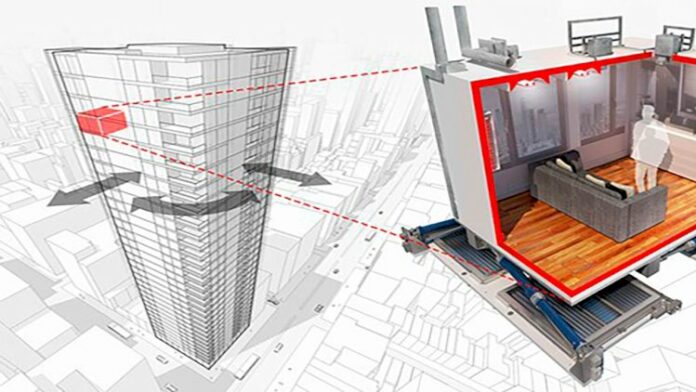The VSimulator facilities are new test platforms that are being built at the universities of Bath and Exeter, consisting of hydraulically-powered moving chambers that allow researchers to study the impacts of vibration and movement on people’s wellbeing in a range of environments, from working and living in skyscrapers and on vessels to operating equipment in industrial environments.
The £4.8 million VSimulator project aims to discover more about how to design environments to make their occupants and operators as safe and as comfortable as possible. The facilities are being developed with funding from the Engineering and Physical Sciences Research Council (EPSRC).
At the University of Bath’s Faculty of Engineering & Design, the box-shaped chamber can sway up to 40cm horizontally which, when combined with climate, sound, air quality and visual controls and highly-detailed 3D virtual reality cityscapes projected onto the internal walls, will allow researchers to accurately measure human responses. This facility will accommodate two occupants for research purposes and will open for commercial and academic use in October 2019.
Meanwhile the University of Exeter are constructing a three-storey building at Exeter Science Park in which to house their VSimulator’s multi-disciplinary platform. This will offer a state-of-the-art, world-class facility that will provide virtual reality (VR) technology capable of immersing up to nine occupants simultaneously in headset-projected VR scenarios. The custom-designed, 4m x 4m motion platform will be able to move in six degrees of freedom and will be linked to the VR scenarios to help users perceive realistic motion as they move around in a virtual world, whilst optical and inertial motion-capture systems and an array of force plates will record their experiences. This facility will be open for commercial and academic use from January 2020 onwards, with applications within and beyond architectural design.
James Brownjohn, Professor of Structural Dynamics and Principal Investigator for VSimulators at University of Exeter, said:
“VSimulators offers opportunities for collaborative international and multi-disciplinary research and innovation, linking academic and commercial communities. Our initial focus will be on factors including vibrations that compromise user experience in the built environment such as wobbly footbridges and bouncy office floors, but we will also study user-centred design of building environments, biomechanics of human balance on moving surfaces and rehabilitation physiotherapy.”
These facilities will not only help design new physical environments, but can also help mitigate the impact of existing environments through better training and enhanced immersion in synthetic environments.
Mike Cottrell, Visualisation Capability Manager from BMT said:
“I’m personally excited by the technical integration the VSimulator motion platform will bring to our immersive solutions at BMT. Integrated immersion will bring a whole new dimension to what we can offer customers to simulate scenarios in a much more realistic way. Being able to move the environment independent of the individuals, whilst keeping immersion synchronised, will be a powerful combination that we are looking forward to exploiting."
Phaedra Gibson, Head of Training at BMT, adds:
“The simulator further enables us to understand human response and measure psychological, physical and physiological responses to the environment. This enables us to design and deliver authentic, meaningful and reliable training solutions to meet the complex operational demands of our customers."



